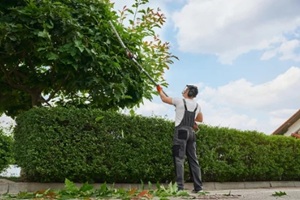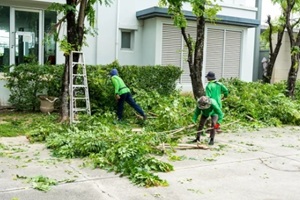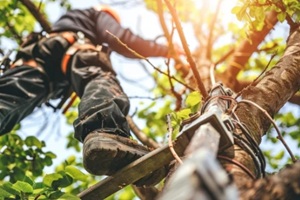
In Northern Virginia, mature trees flourish up and down historic streets. Yet, this density, while beautiful, can lead to fast-spreading tree diseases or obstructive overgrowth. Regular trimming can be more than a maintenance strategy, preventing some of the worst issues that can impact the health and beauty of Virginia landscapes, making it a smarter investment than many property owners realize.
Proper tree trimming begins with a proactive and preservation-focused mindset. The goal of trimming should be to enhance the beauty of the landscape, safeguard its health, and reduce risks.
This guide to tree trimming explains how proper trimming can save the value and beauty of a property from common threats.
1. Trimming Can Mitigate Storm Damage
Summer thunderstorms and hurricanes in the Northern Virginia vicinity bring a variety of threats to healthy trees, particularly heavy wind and rain. When trees are overgrown, they catch more of the wind, buckling under the pressure due to their uneven growing structure. This can cause weak or dead limbs to detach and damage the property or injure people, structures, and animals.
Routine trimming lowers the wind resistance of trees by thinning the canopies and removing excess branches, improving the tree’s chance of surviving the storm. Trimming encourages trees to grow in healthier structures that can better resist these frequent storms, preventing common post-storm repairs such as downed power lines and damaged roofs.
2. Trimming Can Protect Structures and Vehicles
In addition to protecting structures and vehicles from storm-damaged limbs and overturned trunks, regular trimming can reduce other threats caused by unchecked growth. For example,
- Low-hanging branches can scrape roofs, cars, or siding
- Excess tree debris can clog gutters and downspouts
- Branches broken from ice or wind can break windows
- Fallen branches can obstruct paths, driveways, and doors
- In tight-knit neighborhoods, fallen branches can damage the property of your neighbors
3. Trimming Can Preserve Public Property

Overgrown tree roots pose an issue for landscape damage, including sidewalk and structural damage. Yet, fallen branches and trees can become just as destructive, with consequences for the property owner when the debris impacts the usability of public spaces.
As trees continue to grow, they can intrude on fences, walkways, property lines, power lines, and more. This can block visibility from patios and paths while potentially preventing access for people using common spaces like sidewalks. Overgrowth leads to unbalanced growing structures, often causing structural strain to increase until something gives. This often results in damage that property owners have to remove.
4. Trimming Can Reduce Fire Risk
Tree-related fires can also destroy your property. While wildfires are not as common in Virginia as they are in the Midwest, dry summers in heavily wooded areas can still result in damaging fires that put everyone at risk.
Regular tree trimming can mitigate the risk of a wildfire in three essential ways:
- Trimming eliminates deadwood, which often allows fires to spread
- Trimming reduces ground litter, another source of kindling
- Trimming maintains better clearance between trees and structures, preventing fires from spreading between them
Particularly for properties that border parklands or wooded areas, regular trimming can help homeowners keep their property safe from fires.
5. Trimming Can Improve Tree Health
Neglected trees pose immediate risks such as fallen branches and fires. However, they also pose long-term risks to the health of the landscape. As trees overgrow, they become less able to fight off diseases and infestations, which flourish in uncontrolled growth. Without regular maintenance, trees can become infected and die, endangering structures, people, and other plants.
Regular trimming protects trees from common diseases in several ways, including:
- Cutting off infested or infected limbs before they spread to the rest of the tree or other plants
- Reducing canopy overgrowth to increase sunlight and airflow, which increases the vitality of the tree while reducing the risk of dangerous fungal growths
- Balancing structural growth, allowing the tree to withstand more stress due to a healthier and more uniform shape, preventing split trunks, leans, exposed roots, and other common causes of deterioration
Property owners in Virginia contend with many diseases and pests, including oak wilt, thousand cankers disease, emerald ash borers, hemlock woolly adelgid, and more. The cause and trajectory of these pests and diseases differ, but they all have two things in common: they wreak havoc on tree health, and they are highly preventable with regular trimming.
Partner with Tree Care Experts to Preserve and Protect Your Property in Northern Virginia

At RTEC Treecare, our accredited arborists take a preservation-focused approach to tree health. While not all tree health issues are fixable through trimming, it is the most cost-effective long-term strategy to prevent issues before they occur. Overgrowth can not only be unwieldy but also pose real threats to the safety of the property, the value of the home, and the health of the rest of the landscape.
Homeowners in Northern Virginia can contact our team today to learn how tree trimming can help maintain the value and aesthetic of your property for years to come.


